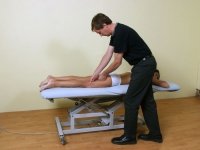Articles
A collection of articles on structural integration and myofascial techniques.
The Vagus Nerve: From Animal Spirits to Poly Vagal Theory
This article traces the development of our understanding of the ANS and the vagus nerve in particular, from the Greeks, to the modern era of Gellhorn, Selyes, Levine and Porges. It will appear in the September issue of Advanced Clinical Education
The notion that the body was fundamentally divided into two systems, an animal (somatic) and organic (autonomic) originated with the ancient Greeks. (Clarke E, 1987). In the second century AD, Galen was able to follow the vagus nerve from the cranium, exiting the jugular foramina and travelling to the organs. (Clarke E, 1987)The Latin word vagus means wandering or rambling which is the type of journey the two branches of that nerve make through the thoracic and abdominal cavities. Galen also identified the sympathetic trunks as crossing the ribs and communicating with the organs via plexuses. He was able to identify most of the cranial nerves but incorrectly grouped the glossopharyngeal, vagus and accessory nerves within the sympathetic trunk, his sixth cranial nerve. Galen saw the nerves as pipes, allowing “animal spirits” to pass between the organs, a process he termed “sympathy”. (Webber, 1978)
Effectiveness of Myofascial Release in the Management of Lateral Epicondylitis in Computer Professionals
Dr M.S. Ajimsha (PhD Physiotherapy) and colleagues conducted a study on the effectiveness of myofascial release in lateral epicondylitis. The author acknowledged the techniques were in part based on those shown in Michael's book Direct Release Myofascial Technique. This study provides evidence the MFR is more effective than a control intervention for lateral epicondylitis in computer professionals. To see a more detailed description see: Archives of Physical Medicine and Rehabilitation.
Objective
To investigate whether myofascial release (MFR) reduces the pain and functional disability of lateral epicondylitis (LE) in comparison with a control group receiving sham ultrasound therapy in computer professionals.
Using Our Bodies More Efficiently
In a recent AMTA survey, the number one issue of concern to therapists was not practice building or increased income. It was how to minimize wear and tear on their bodies.1 It raises the question - just how should therapists use their bodies as they work? In Australia, another survey revealed that the average working life of a therapist is just 3.5 years. Burn-out was listed as the main reason for leaving the profession. There's no escaping the reality that massage therapists do physical work and that takes energy. This understanding is a kind of "Physics 101" reality - work takes energy. Energy conservation for a therapist means getting better at understanding how to use their most essential resource – their own body.

